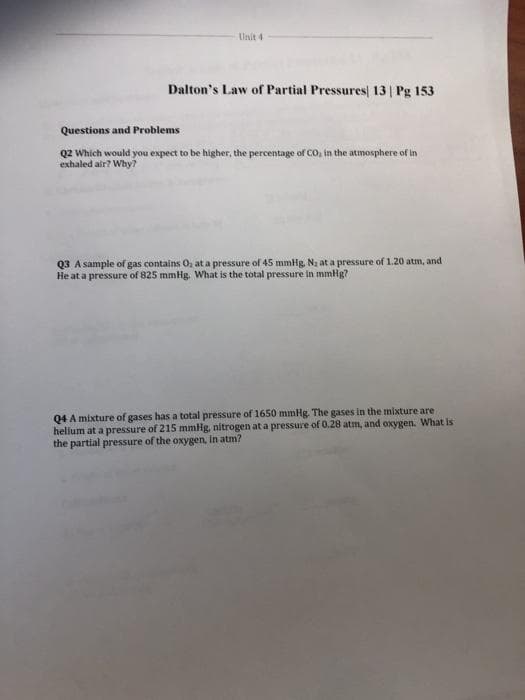Dalton's Law of Partial Pressures 13 | Pg 153 Questions and Problems Q2 Which would you expect to be higher, the percentage of CO, in the atmosphere of in exhaled air? Why? Q3 A sample of gas contains O, at a pressure of 45 mmHg. Na at a pressure of 1.20 atm, and He at a pressure of 825 mmHg What is the total pressure in mmHg? Q4 A mixture of gases has a total pressure of 1650 mmHg. The gases in the mixture are hellum at a pressure of 215 mmig, nitrogen at a pressure of0.28 atm, and oxygen. What is the partial pressure of the oxygen, in atm?
Dalton's Law of Partial Pressures 13 | Pg 153 Questions and Problems Q2 Which would you expect to be higher, the percentage of CO, in the atmosphere of in exhaled air? Why? Q3 A sample of gas contains O, at a pressure of 45 mmHg. Na at a pressure of 1.20 atm, and He at a pressure of 825 mmHg What is the total pressure in mmHg? Q4 A mixture of gases has a total pressure of 1650 mmHg. The gases in the mixture are hellum at a pressure of 215 mmig, nitrogen at a pressure of0.28 atm, and oxygen. What is the partial pressure of the oxygen, in atm?
Chemistry: An Atoms First Approach
2nd Edition
ISBN:9781305079243
Author:Steven S. Zumdahl, Susan A. Zumdahl
Publisher:Steven S. Zumdahl, Susan A. Zumdahl
Chapter8: Gases
Section: Chapter Questions
Problem 89E
Related questions
Question

Transcribed Image Text:Unit 4
Dalton's Law of Partial Pressures 13 | Pg 153
Questions and Problems
Q2 Which would you expect to be higher, the percentage of Co, in the atmosphere of in
exhaled air? Why?
Q3 A sample of gas contains O, at a pressure of 45 mmHg, Na at a pressure of 1.20 atm, and
He at a pressure of 825 mmHg. What is the total pressure in mmHg?
Q4 A mixture of gases has a total pressure of 1650 mmHg. The gases in the mixture are
hellum at a pressure of 215 mmHg, nitrogen at a pressure of 0.28 atm, and oxygen. What is
the partial pressure of the oxygen, in atm?
Expert Solution
This question has been solved!
Explore an expertly crafted, step-by-step solution for a thorough understanding of key concepts.
This is a popular solution!
Trending now
This is a popular solution!
Step by step
Solved in 3 steps

Knowledge Booster
Learn more about
Need a deep-dive on the concept behind this application? Look no further. Learn more about this topic, chemistry and related others by exploring similar questions and additional content below.Recommended textbooks for you

Chemistry: An Atoms First Approach
Chemistry
ISBN:
9781305079243
Author:
Steven S. Zumdahl, Susan A. Zumdahl
Publisher:
Cengage Learning

Introductory Chemistry: A Foundation
Chemistry
ISBN:
9781337399425
Author:
Steven S. Zumdahl, Donald J. DeCoste
Publisher:
Cengage Learning

Chemistry for Engineering Students
Chemistry
ISBN:
9781337398909
Author:
Lawrence S. Brown, Tom Holme
Publisher:
Cengage Learning

Chemistry: An Atoms First Approach
Chemistry
ISBN:
9781305079243
Author:
Steven S. Zumdahl, Susan A. Zumdahl
Publisher:
Cengage Learning

Introductory Chemistry: A Foundation
Chemistry
ISBN:
9781337399425
Author:
Steven S. Zumdahl, Donald J. DeCoste
Publisher:
Cengage Learning

Chemistry for Engineering Students
Chemistry
ISBN:
9781337398909
Author:
Lawrence S. Brown, Tom Holme
Publisher:
Cengage Learning

Chemistry & Chemical Reactivity
Chemistry
ISBN:
9781337399074
Author:
John C. Kotz, Paul M. Treichel, John Townsend, David Treichel
Publisher:
Cengage Learning

Chemistry & Chemical Reactivity
Chemistry
ISBN:
9781133949640
Author:
John C. Kotz, Paul M. Treichel, John Townsend, David Treichel
Publisher:
Cengage Learning

Chemistry by OpenStax (2015-05-04)
Chemistry
ISBN:
9781938168390
Author:
Klaus Theopold, Richard H Langley, Paul Flowers, William R. Robinson, Mark Blaser
Publisher:
OpenStax